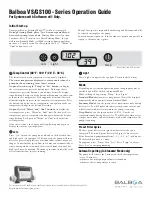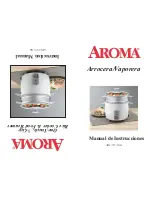
8
Mr. Heater | Portable Big Buddy Radiant Heater
Operating Instructions and Owner’s Manual
NEVER LEAVE THE HEATER UNATTENDED WHILE BURNING!
NEVER LEAVE THE HEATER UNATTENDED WHILE BURNING!
NEVER LEAVE THE HEATER UNATTENDED WHILE BURNING!
Maintenance
•
Always keep the heater area clear
and free from combustible materials,
gasoline and other flammable vapors
and liquids.
•
Keep the vent areas (slots in the
bottom and top of the heater) clear at
all times.
IMPORTANT:
The heater and its
surroundings should be kept clean and
free of dust.
•
Visually inspect the pilot flame and
burner periodically during use. The
pilot flame should be blue in color
(not yellow) and will extend to the
thermocouple. The flame will surround
the thermocouple just below the tip.
See Figure 6.
•
A slight yellow flame may occur where
the pilot flame and main burner
flame meet. The burner should be
bright orange (with a slight blue color
around the border, a red-orange haze
that is visible on the ceramic tile is
acceptable) and without a noticeable
flame.
•
A blue flame that rolls out at the
top of the ceramic tile indicates an
accumulation of dust, lint or spider
webs inside the housing assembly and
main burner assembly. If the pilot is
yellow or the burner has a noticeable
flame, cleaning may be required.
•
It is necessary to periodically check the
burner orifice and burner venturi to
make sure that they are clear of things
such as insect nests and spider webs
that may accumulate over time. A
clogged tube can lead to a fire.
•
Use the following procedure to inspect
the casing assembly and main burner
assembly.
Cleaning Instructions (Refer to
Exploded Parts on Page 10):
IMPORTANT:
Allow heater to
thoroughly cool before performing any
maintenance.
1. Remove disposable 1 lb. cylinder
from heater or turn OFF gas supply at
remote cylinder valve, and disconnect
hose from heater.
2. Remove wire guard from front of
heater by gently bending to remove
from holes in front cover.
3. Remove (4) four screws that secure the
rear cover (ref. # 3) to the heater.
4. Pivot cover outward from bottom.
Release from 2 top clips. Set aside.
5. Remove (3) screws attaching lower
baffle to expose burner air openings.
6. Inspect interior of casing assembly for
accumulation of dust, lint or spider
webs. If necessary, clean interior
casing assembly with a vacuum
cleaner or apply air pressure. Do not
damage any components within
casing assembly when you are
cleaning.
7. Inspect and clean main burner orifice
located at bottom of burner venturi
tube, by using a vacuum or apply air
pressure at orifice opening.
8. Inspect and clean pilot (mounted to
bracket) by using a vacuum or apply air
pressure through the holes in the pilot
indicated by the arrows in Figure 6.
9. Apply air pressure into ceramic tile of
burner assembly and the venturi tube
to remove dust, lint or spider webs.
10. Reinstall lower baffle with (3) screws.
11. Slide back cover over (2) plastic hooks
on top of heater. Make sure rear cover
aligns with plastic side covers and
reinstall (4) screws to hold in place.
12. Replace wire guard.
13. The exterior of the heater can be
cleaned with a damp cloth. Avoid the
direct use of any aerosol or spray-on
cleaners. Do not use abrasive materials
or cleaners on the decals or control
knob.
OFFSEASON
• If the heater is to left “OFF” for a
considerable period of time, the
propane (LP) gas supply to the heater
should be turned off as close to the
gas source as possible. In the case
of portable use, the gas should be
turned off at the propane (LP) gas
supply cylinder.
•
If the heater is put into storage, make
sure to disconnect the propane (LP)
gas cylinder.
•
When the LP-gas cylinder is not
disconnected from the heater, the
heater and cylinder must be located
outdoors, in a well-ventilated space,
out of the reach of children, and must
not be stored in a building, garage, or
any other enclosed area.
•
Storage of the heater indoors is
permissible only if the cylinder is
disconnected and removed from
the heater. Cylinders must be stored
outdoors, in a well-ventilated space,
out of the reach of children, and must
not be stored in a building, garage, or
any other enclosed area.
M
AIN
T
EN
AN
CE
WARNING:
Never use needles,
wires or similar cylindrical objects to
clean the pilot to avoid damaging the
calibrated ruby that controls the gas
flow through the pilot orifice.
Figure 6






































